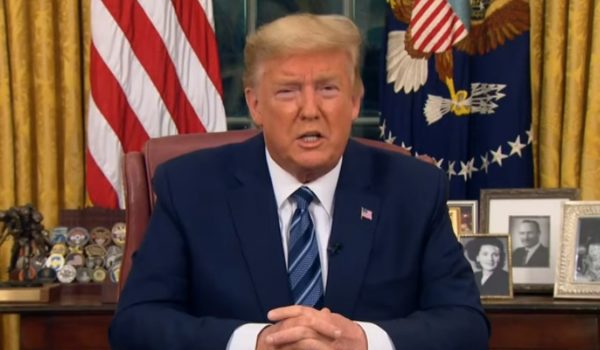
A short while ago, Vladimir Putin endorsed a proposed amendment to the Russian constitution that would enable him to beat presidential term limits and remain in office through 2036.
Although 2036 isn’t that far away anymore, it’s still quite a hitch. The 67-year-old Putin would be 83 by then. (And probably still pretending to do wheelies on motorcycles with biker gangs, and swim in icy waters with sharks.)
Americans have mostly shrugged, because KGB-trained Russian political oligarchs are gonna oligarch, right? (One insightful wag pointed out that Putin is making a personal-security move. You don’t want to get old and vulnerable out of power in Russia, after a career like his.)
Will this presidential election be the most important in American history?
And that’s true enough. But it’s also important not to miss this opportunity for clear sight about an American problem, which is that the “permanent state,” or “Deep State,” or “shadow government,” or whatever you want to call it – the one in America – aspires to be Vladimir Putin, in this cold-dead-fingers sense. It wants to never have to relinquish the reins of government power.
In 2020, Joe Biden is its ticket to that destination. The reason lies not with any overweening urge to summary power in Biden (although he has his peevish moments). It lies with his failing faculties, and the certainty that if he’s elected, others will govern.
There was a time when the U.S. federal government was still too limited for that to be a feasible proposition. A president had to have his wits about him. He made a more limited number of decisions for the nation, but it would have been starkly noticeable if POTUS Actual were not making and executing them. Councils and commissions were too rare, agencies too few, “The Interagency” yet to be dreamt of.
The whole purpose of Progressivism, proper, was to alter that more freewheeling condition: to install a permanent state that would largely turn Congress into a rubber stamp and the president into a figurehead.
The genius of American-style Progressivism was to make it a consortium of the committed from all elements of society, but without declaring revolutionary independence from the old forms – at least not early in the process. Proliferating government agencies was necessary, but not sufficient. There had to be academic theory, school curricula, church teachings and priorities, media bias; a lobbying and consulting industry to write laws, craft strategy, and employ bureaucrats in waiting when their party was out of power; thousands and thousands of state and local agencies and laws conditioning the people to accept bureaucratic intrusiveness from government.
One hundred years ago, this Progressive polity was still being born. Woodrow Wilson was the model and avatar for it in so many ways; it’s no surprise that in his final year in office, he also modeled the non-functional figurehead executive. Wilson was literally unable to function as president from late 1919 to his departure from office in 1921. His wife, Edith, effectively took over in the sense that if things went through the president’s office they went through her. Not, to be sure, an example of a permanent state trundling along on its own, with the obtrusive footprint of a steam calliope – but an early harbinger of that future.
A similar condition with a non-functional president prevailed in the last months of FDR’s life. By that time the federal agencies had begun very seriously to proliferate, but Americans still hadn’t been conditioned to see the trend of the federal government through Progressive eyes, as something that was supposed to be directional and activist, and wasn’t supposed to change. Few at the time recognized that the political vector of Washington had been constant since Calvin Coolidge left office in March of 1929.
FDR’s circle of closest advisers made sure it did not change, as writ large. But by that point numerous bureaus and offices and agencies had been established, to ensure no cobwebs formed and no dust collected for the more specialized policy vectors getting less attention.
Not altering the forms of politics and government was an ingenious approach, soothing Americans who were alarmed at the abrupt, always bloody changes of form wrought by 20th century socialism and communism abroad.
In the 1910s, 1930-40s, and 1960-70s, the U.S. saw adopted the laws and precedents that have done the most to set us up for where we are today: overruled in virtually all aspects of life by the bureaucracies of the federal executive branch.
Not changing the forms of politics and government – just growing some at the expense of others – has blinded us to that transformation.
Interestingly, as each of those paroxysms of law-ramrodding progressed, it culminated in caretaker presidencies. The later 1970s weren’t formally the same as the final months of Wilson and FDR. But in terms of largely unremembered executive paralysis (punctuated by occasional frustrating foolishness), the final months of Nixon, and the presidencies of Ford and Carter, were similar.
We’ve now had 40 years of active, functioning presidencies in which each president, though hemmed about by ballooning legal and procedural mandates, made a signature difference. Donald Trump, like Ronald Reagan, was elected by Americans who consciously wanted a difference made. They wanted the direction of government to change, at the very least. Many want to see government’s velocity and energy level severely reduced.
In a similar way, albeit with some differences, Bill Clinton and Barack Obama were also elected on that premise of changing direction.
But a president who will take initiative to shape the direction of government is not what the permanent state wants. High-velocity, high-energy direction is now its thing – not the voters’. It wants to be Vladimir Putin (or, to pick a model from our own hemisphere, Caudillo-for-Life). It will propose changing the constitution abruptly into its polar opposite (e.g., eliminate the Electoral College) – and yet call that constitutionalism – in order to gain its ends.
Hillary Clinton or Elizabeth Warren would be imperfect but serviceable as a figurehead for a Putinesque permanent state. But Joe Biden comes ready-made for perfection, because he has to be managed by the permanent state. On his own, he’d be non-functional. That has been evident for years; it’s not just a symptom of what looks, when we see him in action, like physical frailty and early dementia.
Biden is suited, at least for the moment, for retail politics, and being a figurehead for a staff that does all the work. If he becomes more outburst-prone and less intelligible, he’ll lose the retail politics facility. But for now, he can be embraced by the voters of the old-school Left precisely because they can count on the permanent state being Vladimir Putin if he’s elected. They think of that as getting back to normal. For the permanent state, and probably for more Biden voters than we imagine, it’s a feature, not a bug.




